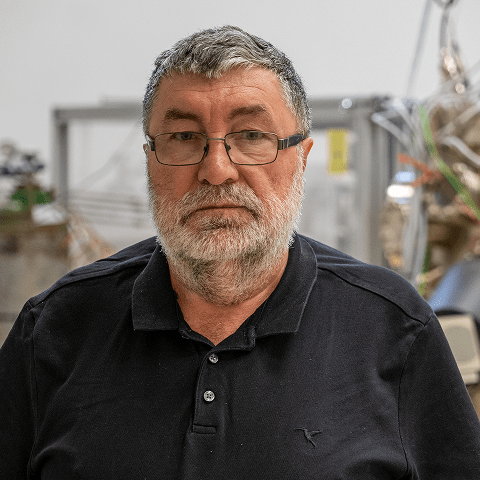Miroslav Zahoran, doc. RNDr., CSc.
Academic, Scientific Research Department

Bio
2024-present: University teacher – Associate professor in physics, Comenius University, Faculty of Mathematics, Physics and Informatics, CENAM
2011-2024: University teacher – associate professor in physics, Comenius University, Faculty of Mathematics, Physics and Informatics, Department of Experimental Physics
2004-2011: Researcher in the field of plasma physics, Comenius University, Faculty of Mathematics, Physics and Informatics, Department of Experimental Physics
1997-2004: Assistant Professor in Plasma Physics, Comenius University, Faculty of Mathematics, Physics and Informatics
1991-1997: Researcher in the field of plasma physics, Comenius University, Faculty of Mathematics, Physics and Informatics
1989-1991: Research Assistant in Plasma Physics, Comenius University, Faculty of Mathematics and Physics, Department of Plasma Physics
1985-1989: Research Assistant in Plasma Physics, Comenius University, Faculty of Mathematics and Physics, Department of Experimental Physics
1982-1985: Internal postgraduate studies, Comenius University, Institute of Physics and Biophysics
1978-1982: Study stay, SAS, Institute of Physics
Education
Associate Professor in Physics
Candidate of Mathematical and Physical Sciences – CSc. in the field of Plasma Physics
Doctor of Natural Sciences – RNDr. - Physics / Plasma Physics
University studies - Physics / Physical Electronics and Optics – specialization Plasma Physics
Internships
Internship
Internship
Internship
Internship
Internship
Internship
Reviewer activities
M.Kopani, Š.Polák: Úvod do mikroskopických techník
Other activities
Scientific and technical cooperation on plasma etching
SEM and EDX analysis of ceramic materials
Scientific and technical cooperation on Study of the conditions for the formation of a hard coating based on C3N4
Scientific and technical cooperation on Deposition of cubic boron nitride hard coatings
Scientific and technical cooperation on plasma immersion ion implantation
Structural Funds project Improving the quality of the use of sophisticated equipment and methods in research and teaching at the Institute of Materials Research
Guidebook “Prognosis of development of UVP Slovakion inclusive of scientific and research activities” for establishment and development of the Scientific University Park CAMBO
Teaching activities
Courses taught
Course Objectives
Expansion and deepening of knowledge in the field of plasma generation at low and high pressures and its application in modern plasma technologies.
Syllabus
Specifics of plasma generation at low, medium and high pressures. Equilibrium and non-equilibrium plasma. Basic types of plasma sources and reactor configurations. Plasma generation at low pressure – capacitively and inductively excited rf discharge, ECR and helicon discharge; physical models for etching, deposition and plasma implantation. Plasma generation at atmospheric pressure – arc plasma torch, corona discharge, plasma-jet, plasma pen, microwave torch, dielectric barrier discharges, their various types and configurations. Applications: cleaning, surface activation and modification, layer deposition, etc.
Course Objectives
To develop a contribution to the conference through mutual cooperation.
Syllabus
Theory: Capacitively excited rf discharge – homogeneous model (plasma admittance, boundary layer admittance, time change of potential in the boundary layer, electron temperature in plasma, plasma concentration, total dissipated power in rf discharge); calculation of DC bias; calculation of electronic parameters for the matching element. Experiment: Plasma modification of the selected material, measurement of electrical parameters of rf discharge, end-point detection using OES. Analysis of the modified surface using SEM, EDX, WDX, XPS and FTIR.
Output: Processing of measured data and their discussion, preparation of a poster and/or oral presentation.
Course Objectives
Expanding knowledge of the physical principles of analytical methods used for the diagnosis of liquid, gaseous and solid substances. Students will be able to choose the optimal analytical method for plasma-treated samples.
Syllabus
Analytical methods evaluating plasma-modified products; gaseous: IR spectroscopy, gas chromatography, gas chromatography + mass spectrometry, ion mobility spectrometry, chemiluminescence, liquid: electron paramagnetic resonance (EPR), liquid chromatography, absorption, transmission and scattering (UV, IR, Raman) spectrometry, solid: surface energy measurement, electron microscopy (SEM, TEM, EDX, WDX), X-ray photoelectron spectroscopy (XPS), secondary ion mass spectrometry (SIMS).
Course Objectives
Application and deepening of theoretical knowledge of plasma physics. Students will be able to use the acquired knowledge in the implementation of new plasma technologies in practice (microelectronics, surface treatment engineering, nanotechnology, biomedicine, environmental protection and new energy sources).
Syllabus
Basic mechanisms of plasma generation. Plasma-chemical reactions, homogeneous and heterogeneous. Technical plasma sources. Classification of plasma technologies. Surface treatment of solids, plasma deposition, plasma implantation. Plasma technologies in microelectronics, plasma-chemical and ion-reactive etching. Plasma technologies for sterilization and biomedical applications, biocompatibility of implants, antimicrobial surface treatment. Plasma technologies for environmental protection, removal of gaseous pollutants, solid particles, water purification. New energy sources, thermonuclear fusion, ITER.
Students supervision
Supervisor of bachelors, master, and PhD. students.